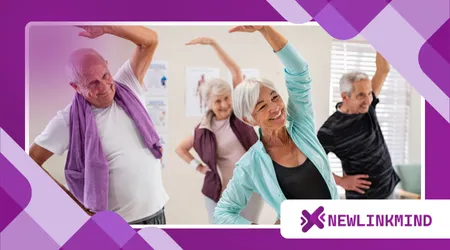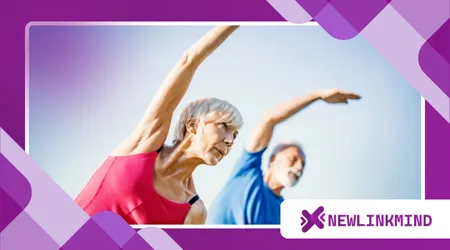Yoga for Seniors: Stretching Safely at Every Stage of Life

Stretching safely at every stage of life. The journey through life’s decades is unique for everyone. It presents new challenges and new opportunities.
Anúncios
Finding a path to wellness is essential. Yoga emerges as a powerful tool. It is a guide for aging gracefully.
This ancient practice is about mindful movement. It is not about perfect poses. It is a philosophy for your body.
The Foundation of Longevity: Why Flexibility Matters
Maintaining range of motion becomes crucial as we age. It’s a key component of independence and well-being.
Our muscles naturally shorten and tighten over time. Joints can become less lubricated and stiff. These changes affect our daily tasks. Simply reaching for an item becomes harder.
Anúncios
A consistent stretching routine helps. It promotes healthy blood flow to muscles. This nourishes the tissues and joints.
Stretching also reduces the risk of injury. It prepares your body for daily activities. A flexible body is a resilient body.
The Yoga Approach: A Gentle Philosophy for Your Body
Yoga offers a holistic method to flexibility. It is more than a physical exercise. It’s a practice of deep listening.
Anúncios
The goal is to feel, not to force. It’s a stark contrast to other forms of exercise. The focus is on controlled, gentle movements.
Think of your body like a river. In youth, it flows effortlessly. Over time, it can become stagnant.
Yoga is the practice of clearing away debris. It allows the water to flow freely again. This mindful approach prevents strain.
Read more: Breathing Exercises and Gentle Yoga for Seniors
It protects you from over-extension. Yoga teaches us to honor our body’s limits. It’s about adapting the pose to the person.
It is not about fitting the person into a pose. This is the core principle of stretching safely at every stage of life.
Essential Poses for Senior Practitioners
Chair-supported poses are fantastic for stability. They build confidence without a risk of falling.
Consider a Chair-Supported Seated Twist. Sit tall, with your spine long. Gently turn your torso to one side.
You hold onto the back of the chair. The chair provides a secure anchor. This pose improves spinal mobility. It also aids digestion.
Another great example is Wall-Assisted Downward Dog. Stand a few feet from a wall.
Place your hands on the wall. Walk your feet back until your body forms an “L” shape. This pose stretches the hamstrings. It decompresses the spine.
These adaptations are vital for a sustainable practice. They allow for a safe and effective approach.

Integrating Yoga into Your Daily Life
Consistency is far more important than intensity. A short, daily routine is best. Even ten minutes can make a difference.
It helps maintain the gains you’ve made. A morning practice can energize you. A nighttime session can aid relaxation.
Check this out: The Mental Health Benefits of Yoga for Seniors
A significant study by the American College of Sports Medicine found that regular physical activity, including yoga, can reduce the risk of falls in older adults by up to 30%.
This is because yoga improves balance and muscle strength, which are key to fall prevention.
Here is a simple routine for building your practice.
| Pose/Stretch | Benefit | Modifications for Safety |
| Seated Cat-Cow | Spinal flexibility, core strength | Use a chair for support. Keep hands on knees. |
| Legs-Up-The-Wall | Relieves leg swelling, calms nervous system | Use a cushion under hips for comfort. |
| Seated Forward Fold | Stretches hamstrings, soothes mind | Bend knees generously. Use a strap around feet. |
Common Mistakes to Avoid in Your Practice
One of the most common mistakes is ignoring pain. There is a difference between stretch and pain. A stretch should feel like a deep release.
Pain is your body’s alarm system. Never push into any sharp or shooting pain.
Another error is comparing yourself to others. Social media often displays extreme flexibility. This can lead to an ego-driven practice.
See how interesting: Morning Silence: The Secret to a Happier Day
Your journey is uniquely yours. Are we not here to find our own strength, not to imitate someone else’s? Remember, the aim is stretching safely at every stage of life.
Using props is a sign of wisdom, not weakness. Blocks, straps, and blankets are your friends. They help bring the pose to you. They are essential tools for stretching safely at every stage of life.
The Holistic Benefits Beyond Flexibility
The benefits of yoga extend beyond the mat. It’s about nourishing your entire being. This practice has a profound effect on mental health.
The mindful breathing techniques reduce stress. Yoga helps calm the nervous system.
It can be a powerful antidote to anxiety. A consistent practice can improve sleep quality. It is a fantastic tool for managing stress.
Yoga fosters a stronger mind-body connection. This enhanced awareness is crucial. It helps you tune into your body’s signals.
This is a powerful aspect of stretching safely at every stage of life.

Embracing a Lifetime of Wellness
Yoga is a lifelong companion. It is not a temporary fix. It adapts as you do.
The practice evolves with your body’s needs. Your mat is a place of self-discovery. It’s a space for honoring your body.
Ultimately, it is a journey of listening. Your body has incredible wisdom. Yoga helps you reconnect with it.
The practice supports a vibrant, active future. It’s about finding joy in movement and stillness.
A commitment to stretching safely at every stage of life is a commitment to yourself.
FAQ
Is yoga safe if I have arthritis or joint pain?
Yes, when done properly with modifications. Look for classes that focus on gentle, adaptive movements. A qualified instructor can guide you. Avoid any poses that cause pain in your joints.
How often should a senior practice yoga?
Consistency is key. Aim for 3-5 times a week. Even 15-20 minutes a day is more effective than one long session. Listen to your body and rest when you need to.
Do I need any special equipment to get started?
Not necessarily. A mat is helpful for grip. A sturdy chair can be used for support. Over time, you may find props like blocks or straps beneficial. Use what you have at home first.
Can yoga improve my balance and prevent falls?
Absolutely. Yoga poses often challenge and improve your balance.
It strengthens your core and leg muscles, which are vital for stability. Consistent practice significantly reduces your risk of falls.
++ Chair Yoga for Seniors: Gentle Exercises to Stay Active and Independent
++ Yoga for Seniors: Embracing Wellness and Serenity Through Gentle Movements
